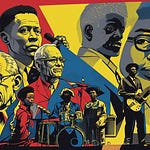EDITOR'S NOTE: BURSTING THE BUBBLE
Dear Reggaeologists,
Welcome to our May edition of Reggaeology. This month, we're tackling a sensitive but crucial conversation about success, perception, and the realities of the global music industry as it relates to our beloved Caribbean sounds.
After three decades immersed in this industry, I've noticed patterns that deserve honest discussion. Today we're examining what I call the "Diaspora Music Bubble" – that self-contained ecosystem that both nurtures our culture and sometimes limits our global reach.
Pour yourself something strong. This might sting a little.
Are we confusing community love with mainstream success?
The energy is electric. The venue is packed. Everyone knows every word to every song. The artist on stage is being treated like royalty, and in this moment – in this space – they truly are.
But step outside the venue, walk five blocks away, ask random pedestrians if they know this "star," and you'll get blank stares.
This is the paradox of the diaspora music bubble – a phenomenon where Caribbean artists achieve intense, passionate fame within cultural enclaves while remaining virtually unknown in the broader music landscape.
What Is the Bubble?
The diaspora music bubble encompasses the network of Caribbean community events and festivals, specialty radio shows and stations, cultural venues in cities with large West Indian populations, diaspora-focused media outlets, and community DJs and promoters who create a vibrant ecosystem for our music.
This network is vital – it preserves our culture, provides economic opportunities, and keeps our music alive thousands of miles from its birthplace.
But when we mistake this bubble for the entire ocean of global music, we create strategic blind spots that can limit true growth.
Five Hard Truths About the Bubble
1. Community Stardom ≠ Mainstream Success
Being a headliner at Notting Hill Carnival or a Caribbean festival in Brooklyn is a significant cultural achievement – but it's categorically different from having cross-demographic appeal. True mainstream penetration means regular rotation on national Top 40 radio, rather than just urban or Caribbean stations.
It means presence on general audience playlists instead of only genre-specific ones. It means recognition across diverse audiences who have no Caribbean connections whatsoever.
The conversations happening in the industry boardrooms are different from those happening at community events, and bridging this gap requires strategic understanding of both worlds.
2. Those Streaming Numbers Need Context
"My track has 2 million streams!" sounds impressive, but where are those streams coming from?
Are they concentrated in diaspora communities? Are they from markets where streaming pays fractionally less?
The digital landscape has made it easier than ever to reach dedicated fans, but it's also created new mirages of success.
Without broader context, digital metrics can create an illusion of mainstream breakthrough when you're actually experiencing concentrated community support – valuable, but different from true crossover appeal.
Understanding the geographic and demographic breakdown of your audience is crucial for strategic growth beyond the bubble.
3. Event Promotion vs. Industry Reality
We've all seen the event flyers declaring artists as "international superstars" when in reality, their recognition barely extends beyond specific cultural communities.
This isn't just misleading marketing – it creates false expectations and strategically misaligned careers. The uncomfortable question every artist needs to ask: Could I sell out a venue in cities without significant Caribbean populations? Would my music resonate with audiences who didn't grow up with these sounds?
Promoters within the diaspora circuit often inadvertently reinforce the bubble by overstating an artist's mainstream significance, making it harder to see the work needed to truly cross over.
4. The Brand Strategy Gap
Mainstream crossover typically requires strategic adaptation without cultural dilution, thoughtfully planned cross-genre collaborations, comprehensive media training, and investment in multi-market PR.
Many Caribbean artists invest heavily in studio time but underinvest in these critical brand elements.
The most successful crossover artists maintain their cultural authenticity while finding universal themes and presentation styles that invite broader audiences in.
This isn't about watering down the music – it's about understanding how to translate its power in ways that resonate beyond those who already understand its cultural context.
5. The Touring Test Doesn't Lie
Perhaps the most undeniable evidence of mainstream status comes from touring capacity outside diaspora strongholds.
Can you tour general market festivals and venues not specifically marketed to Caribbean audiences? Artists like Damian Marley, Shaggy, and more recently Koffee and Chronixx have developed shows that pull diverse crowds – not just reggae aficionados.
They've found ways to present Caribbean music in contexts where it's appreciated for its artistic merit rather than just its cultural significance. This crossover isn't accidental – it comes from intentional strategy and presentation that honors the roots while branching outward.
Using the Bubble as a Launchpad, Not a Ceiling
The diaspora network isn't a limitation – it's a foundation. The question becomes: how do we use this incredible base of support to build bridges to wider audiences?
Successful artists understand mainstream industry metrics while preserving cultural authenticity. They develop strategic collaborations that introduce their sound to new ears without compromising their essence.
They invest in professional teams with experience navigating both worlds, and create content that maintains identity while inviting in the uninitiated.
The bubble provides the security and support to experiment, but the true art is knowing when and how to push beyond its comfortable confines.












Share this post